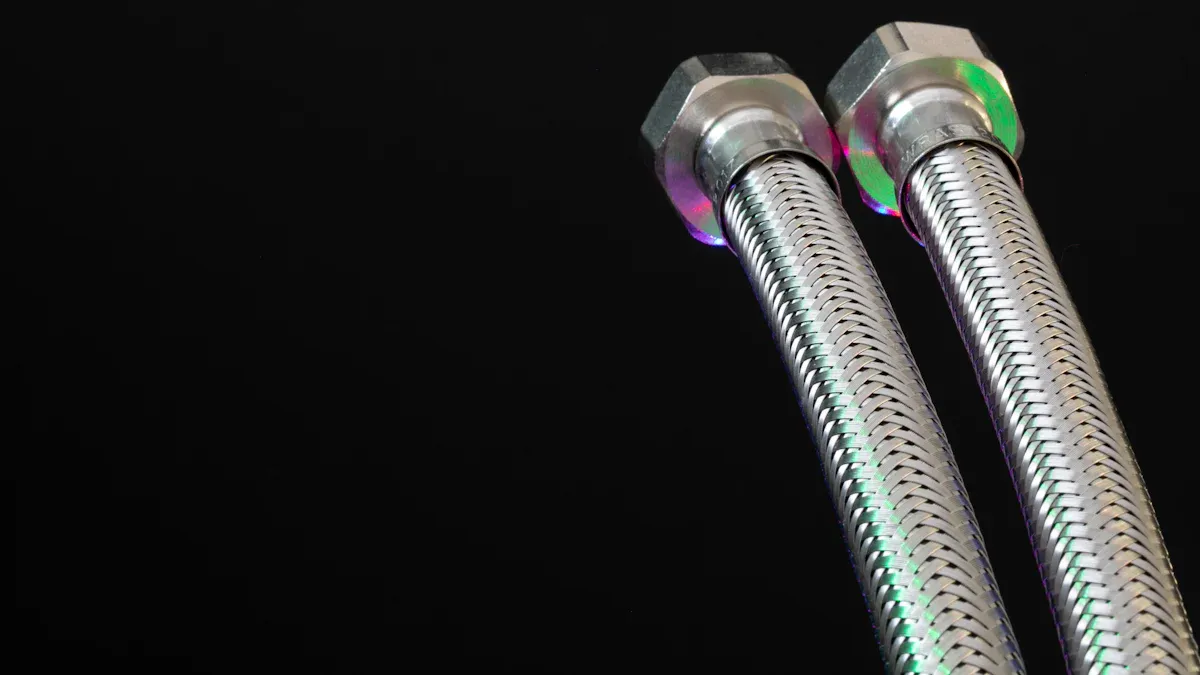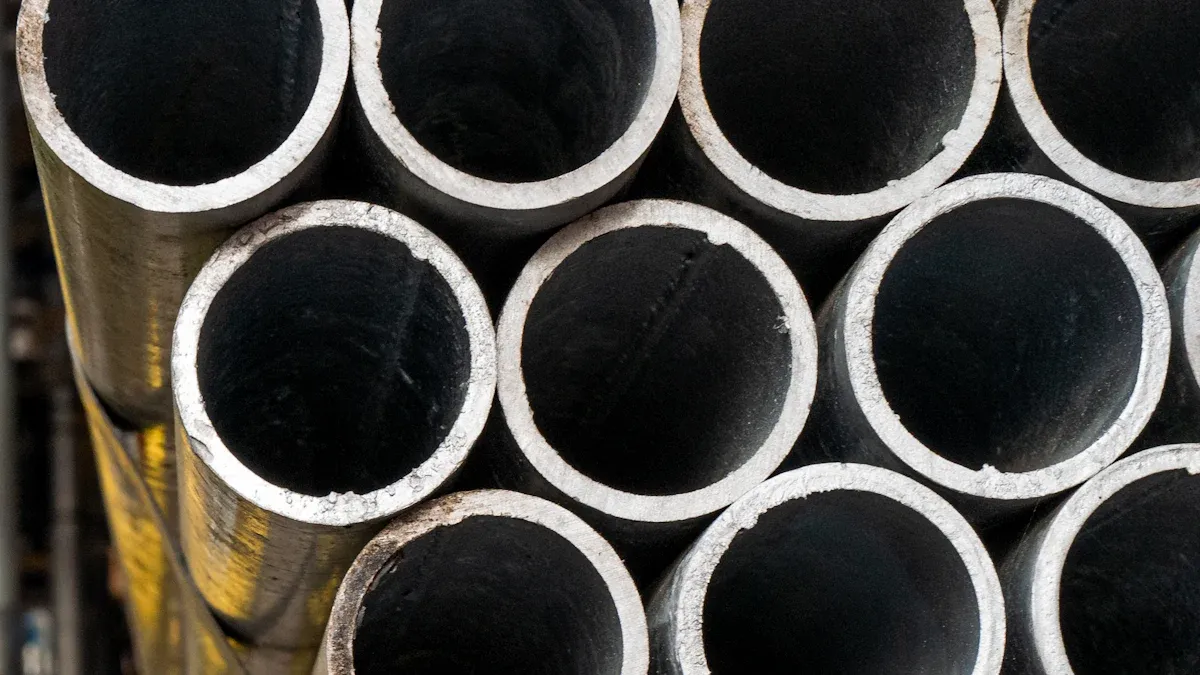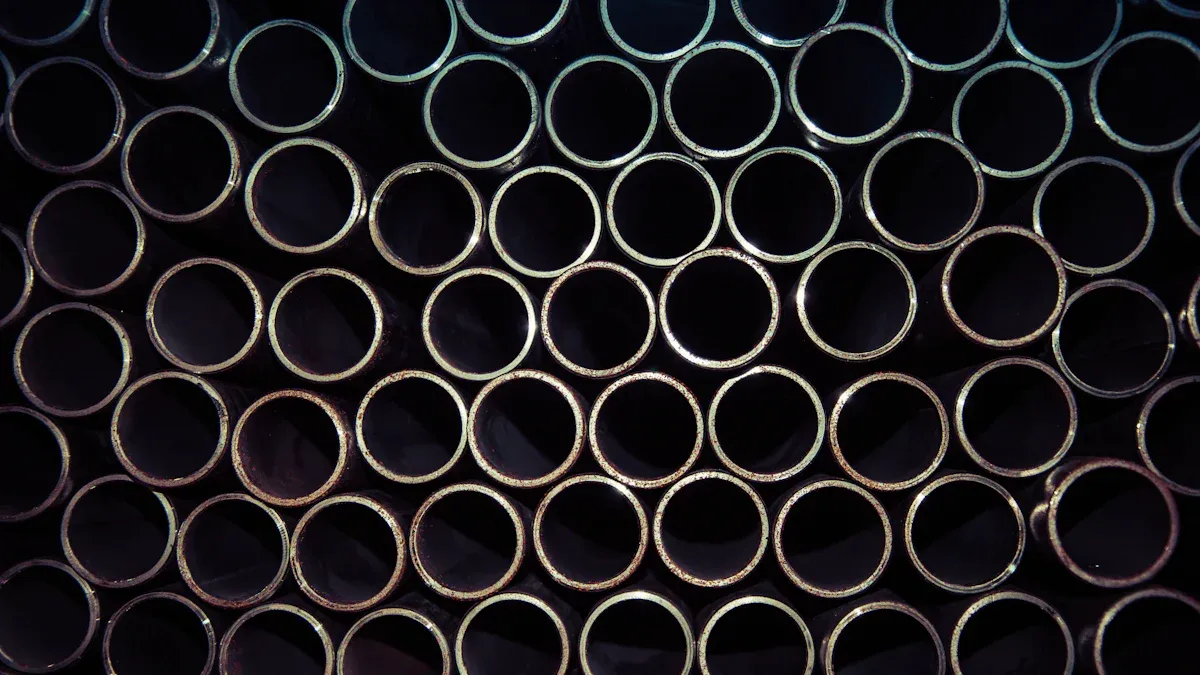Understanding High Purity Nitinol Tubing 55Ni-45Ti Alloy

High purity Nitinol tubing 55Ni-45Ti alloy is important in engineering and medicine. This special material is made of 55% nickel and 45% titanium. It has amazing features that make it better than regular alloys. One key feature is its ability to "remember" its shape. After being bent or stretched, it can return to its original form. This is called the shape memory effect and is useful for precise and reliable tools.
Another great feature is superelasticity. This means it can handle a lot of stress without staying bent or broken. Many industries need this material because of its unique abilities. For example:
The global Nitinol market may grow from USD 2.29 billion in 2024 to USD 4.76 billion by 2034.
This growth shows a yearly increase of 7.60% from 2025 to 2034.
Tubing is expected to lead this growth because it is used in surgeries that don’t need big cuts.
From medical devices to advanced technology, high purity Nitinol tubing 55Ni-45Ti alloy helps create new ideas and solutions.
Key Takeaways
High purity Nitinol tubing has special traits like shape memory and flexibility. This makes it perfect for medical tools like stents and guidewires.
Purity is key for Nitinol to work well. Using advanced methods, like vacuum arc remelting, makes the tubing stronger and more dependable.
Nitinol does not rust and is safe for the body. This makes it great for long-term use in medical implants.
More industries, like aerospace and robotics, now use Nitinol. It is strong and works well in tough conditions.
In the future, Nitinol may be used in AI-made stents. Thinner designs could help with easier surgeries and better healing.
Overview of High Purity Nitinol Tubing 55Ni-45Ti Alloy
Nickel Titanium Alloy Composition
Nitinol is made from nickel and titanium. High purity Nitinol tubing has 55% nickel and 45% titanium. This exact mix gives it special abilities like shape memory and superelasticity.
Here’s a table showing the elements before and after coating:
Element | Before Coating (%) | After Coating (%) |
|---|---|---|
Ni | X% | Y% |
Ti | A% | B% |
C | C% | D% |
O | E% | F% |
This balance makes the alloy work well in tough jobs, like medical tools or airplane parts.
Shape Memory Alloy Features
Nitinol can return to its original shape after being bent. This happens because of changes in its structure when heated. For example, heat makes it "remember" its first shape and go back to it.
Tests show how strong this property is. One test found it could stretch up to 14% under tension. Another test showed about 10% strain under compression. These results prove it can handle stress and stay strong.
Alloy Type | Test Type | Strain (%) | Notes |
|---|---|---|---|
Ni51.2Ti23.4Hf25.4 | Compression | ~10% | Tested at 250 MPa pressure |
Ni50.3Ti25Hf24.7 | Tension | ~14% | Aged samples marked as triangles |
NiTi13Hf | Compression | ~7% | Superelasticity test |
Its shape memory and superelasticity make it perfect for precise and durable uses.
Why High Purity Matters in Nitinol Tubing
Purity is very important for Nitinol's performance. Impurities can make it weaker and less durable. Special methods like vacuum arc remelting (VAR) and vacuum induction melting (VIM) help make it very pure.
This table shows how purity affects its strength:
Nitinol Grade | Description | Fatigue Life Impact |
|---|---|---|
Standard Grade VAR | Normal purity from basic methods | Lower fatigue resistance |
High-Purity VAR | Very pure materials | Better fatigue resistance |
Process Optimized VIM-VAR | Fewer non-metallic particles | Stronger and more reliable |
Using high-purity Nitinol tubing ensures better results. It works best in important areas like medical implants and airplane parts. Its purity makes it reliable and long-lasting, which industries need.
Unique Properties of Nitinol Alloy

Shape Memory Effect and Superelasticity
Nitinol has a cool shape memory effect. This means it can go back to its original shape after being bent. It happens because of changes in its structure between two phases, called austenite and martensite. When heated, it "remembers" its first shape and returns to it. The temperature at which this happens is important for how it works in different situations.
Tests show that Nitinol changes its structure when under pressure at certain temperatures. This change helps it stretch or bend without breaking, showing its superelastic and shape memory abilities. For example, Nitinol stents can be squeezed and expanded without staying bent. This makes them great for medical use. Scientists also study how stress changes its structure to improve its flexibility and strength.
Superelasticity is another amazing feature. It lets Nitinol handle a lot of stress without breaking. This is useful for things like braces and surgical tools. Together, shape memory and superelasticity make Nitinol perfect for precise and flexible designs.
Corrosion Resistance and Biocompatibility
Nitinol is special because it doesn’t rust easily and is safe for the body. This makes it a top choice for medical tools and implants. Its resistance to rust keeps it strong, and its safety with body tissues makes it reliable.
Here are some findings from studies:
Magnesium alloys like Mg–Zn and Mg–Ca help bone cells grow without being toxic.
Surface treatments like micro-arc oxidation (MAO) make alloys stronger and safer while stopping rust.
Alloys like MgY4 and MgAl9Zn1 are safe for medical use and resist corrosion well.
Tests prove these points. For example, Nitinol implants work well inside the body. Studies show they don’t rust in body fluids and last a long time. Special surface treatments make them even better for medical devices.
Because it resists rust and is safe for the body, high purity Nitinol tubing 55Ni-45Ti alloy is great for important uses like stents and implants.
Thermal and Mechanical Stability
Nitinol stays strong under heat and pressure. This makes it a good choice for tough jobs. It can handle extreme temperatures and stress without failing.
Heat tests show that laser-treated Nitinol gets hotter faster than regular materials. Its surface temperature can be 18% higher in just one second. The heat creates stress, reaching over 450 MPa in some parts. A special layer in the alloy helps manage this heat by acting as a barrier.
Strength tests show Nitinol is very tough. Cracks or peeling can happen if the heat stress is too high. But Nitinol’s unique features reduce these problems. Studies show Nitinol rods are stronger than titanium rods when twisted, proving their durability.
Nitinol’s heat memory and strength make it perfect for jobs needing precision and toughness, like airplane parts and robots.
Applications of High Purity Nitinol Tubing

Medical Applications: Stents and Guidewires
High purity nitinol tubing is very important in medicine. It is used in stents and guidewires because of its special features. These include shape memory and superelasticity, which help it work well in the body. For example, stents made from nitinol can expand to fit blood vessels. This helps keep blood flowing properly. Guidewires use nitinol for its flexibility and strength. This makes them great for moving through tricky blood vessel paths.
Studies show nitinol works well in heart implants. For example:
Study | Sample Size | Technical Success | Patency Rate | Restenosis Rate |
|---|---|---|---|---|
Mewissen (2004) | 137 | 98% | 92% at 6 mo | N/A |
Zeller et al (2008) | 110 | 96% | N/A | 23.3% at 1 yr |
Kickuth et al (2007) | 35 | N/A | 82% at 6 mo | 100% limb salvage |
These results prove nitinol is reliable for medical devices. It is safe for the body and lasts a long time. Stents made from nitinol can handle millions of bends without breaking. This makes them perfect for long-term use in heart treatments. Nitinol also lowers the chance of breaking and keeps its shape under stress.
Nitinol is also used in clot-removal tools. These tools use self-expanding stents to clear blood clots. The stents are squeezed into a small tube and then expand back to their original size. This helps remove clots effectively. Using high-quality nitinol tubing improves results in medical tools like stents and guidewires.
Industrial Applications: Robotics and Aerospace
Nitinol is not just for medical tools; it’s also great for industries. It is used in robotics and aerospace because it is strong, flexible, and heat-resistant. In robotics, nitinol tubes make parts that can bend a lot but still work. This is helpful for robots that need to move precisely and last a long time.
A study showed nitinol tubes helped reduce bending in robotic systems. This improved how well the robots worked under pressure.
In aerospace, nitinol is lightweight and handles high heat well. This makes it useful for airplane parts and car systems. The table below shows why nitinol is valuable in these fields:
Application Area | Key Benefits |
|---|---|
Aerospace | Handles high heat, lightweight, good for planes and cars. |
Robotics | Strong, flexible, and resists bending in robot parts. |
Experts say design and material choice affect how nitinol performs. This knowledge helps improve nitinol for industrial uses. By using nitinol’s strength and flexibility, engineers can create better robots and airplane parts.
Emerging Uses in Advanced Technologies
Nitinol is also being used in new technologies. One example is self-expanding nitinol frames for heart treatments. These frames are small and easy to guide through blood vessels. The table below explains this advanced use:
Feature | Description |
|---|---|
Application | Self-expanding nitinol frame for heart treatments |
Design | Small frame for better control and movement |
Size | Fits in small tubes, expands up to 15 mm |
Testing | Includes computer models and lab experiments |
Performance | Very little bending, balanced forces, and smooth movement |
Nitinol is also being tested for smart materials and moving parts. These projects use its shape memory and flexibility to make responsive systems. For example, nitinol tubes are being tried in advanced robots. They can bend many times without breaking, which is important for these machines. As technology grows, nitinol’s uses will expand even more.
By learning about nitinol’s benefits, you can create better tools and systems. Whether in medicine, robotics, or new fields, nitinol offers unmatched strength and reliability.
Challenges and Advancements in Nitinol Alloy Manufacturing
Challenges in Producing High Purity Nitinol Tubing
Making high purity nitinol tubing 55Ni-45Ti alloy is not easy. It needs a strong understanding of how the material behaves under stress. Without this knowledge, the tubing might break. Cutting nitinol is also tricky. Regular cutting tools don’t work well, so special methods are used.
Another challenge is creating a titanium oxide layer. This layer stops nickel from leaking into the body, making it safe. Steps like electropolishing and passivation help form this layer. For medical-grade tubing, strict rules must be followed. Manufacturers need to meet tough standards for implants.
Challenge | Description |
|---|---|
Material Knowledge | Deep understanding of nitinol properties and fatigue behavior is needed. |
Low Machinability | Regular cutting tools don’t work; special methods are required. |
Electropolishing and Passivation | Helps create a titanium oxide layer to stop nickel leakage. |
Process Validation | Strict checks ensure tubing meets medical implant standards. |
These challenges show why making high-quality nitinol tubing is complex. Manufacturers spend a lot on research to solve these problems.
Innovations in Manufacturing Techniques
New methods have made nitinol tubing production better. Laser cutting and shape-setting allow precise control of tubing size. But only a few factories have the tools for these advanced techniques.
Quality checks have improved too. Following ISO 13485 and FDA rules ensures tubing meets medical needs. Still, some tubing fails during tests. A new way to join nitinol with other metals, like stainless steel, is being developed. This could open up more uses for nitinol tubing.
Getting pure nickel and titanium is another issue. Nickel prices went up by 250% in 2022, making supplies unstable. Shipping nitinol tubing needs special temperature-controlled spaces, which costs more. There’s also a shortage of skilled workers, with a 17% gap expected by 2025.
Supply Chain Issues: Pure nickel and titanium are hard to get.
Precision Manufacturing: Laser cutting and shape-setting improve tubing quality.
Quality Checks: ISO 13485 and FDA rules ensure safety.
Shipping Costs: Temperature-controlled shipping adds expenses.
Geopolitical Risks: Nickel supplies depend on unstable regions.
Worker Shortages: Fewer skilled workers may slow production by 2025.
These changes show how nitinol tubing makers are adapting to meet demand.
Future Trends in Nitinol Applications
The future of nitinol tubing looks exciting. Artificial intelligence (AI) is helping create custom stents for patients. These stents are safer and more accurate. Another trend is making stents thinner. Thin stents allow less invasive surgeries and can move through tight spaces easily.
Better biomaterials are also being developed. Scientists are working to make nitinol stents safer and stronger. These improvements will help patients recover better over time. As technology grows, nitinol tubing will be important in medicine and industry.
AI-designed stents: Custom stents improve safety and accuracy.
Thinner stents: Less invasive surgeries with ultra-thin designs.
Improved biomaterials: Safer and stronger stents for better patient outcomes.
These trends show how nitinol tubing will shape the future of healthcare and technology.
High purity Nitinol tubing 55Ni-45Ti alloy is very special. It can "remember" its shape and bend without breaking. This makes it perfect for medical tools like stents and catheters. These tools need to be safe for the body and last long. Outside of medicine, its strength and flexibility help in planes and cars. Scientists are finding new ways to use this alloy. It will be important for future ideas in medicine and engineering.
FAQ
What makes high purity Nitinol tubing special?
High purity Nitinol tubing is unique because it can "remember" its shape. It bends or stretches but returns to its original form. It also handles stress without breaking. Its ability to resist rust and be safe for the body makes it great for medical and industrial uses.
How does Nitinol's shape memory work?
Nitinol changes between two forms called martensite and austenite. Heat makes it switch back to its original shape. This feature is very useful for tools like stents and guidewires.
Why is purity important for Nitinol tubing?
Purity makes Nitinol stronger and last longer. Impurities can weaken it and make it less reliable. Special methods like vacuum arc remelting remove impurities. This makes it perfect for medical implants and airplane parts.
Can Nitinol tubing work in tough conditions?
Yes, Nitinol tubing works well in extreme situations. It can handle high heat, rust, and heavy pressure. These features make it useful for planes, robots, and advanced medical tools.
What are the challenges in making Nitinol tubing?
Making Nitinol tubing is hard. Cutting it needs special tools, and a protective layer must be added. Strict rules ensure it’s safe for medical use. Advanced methods like laser cutting help make high-quality tubing for important jobs.
See Also
The Process of Creating Nitinol Tubing for Healthcare Uses
Evaluating Nitinol Tubing's Strength Against Stainless Steel
A Comprehensive Overview of Nitinol Parts and Production Methods
The Importance of Nitinol Tubing in Modern Medical Practices

